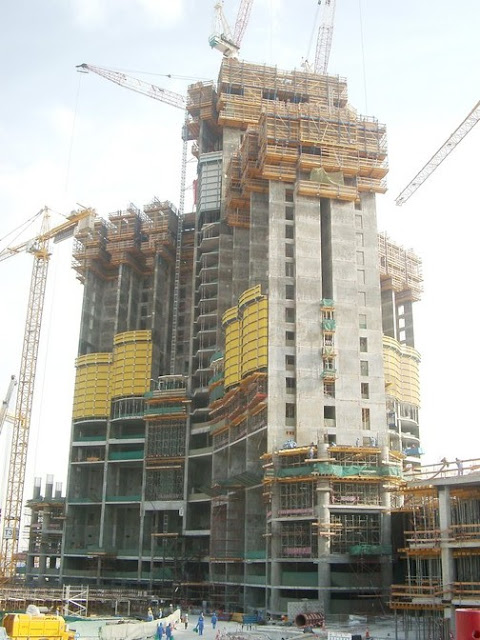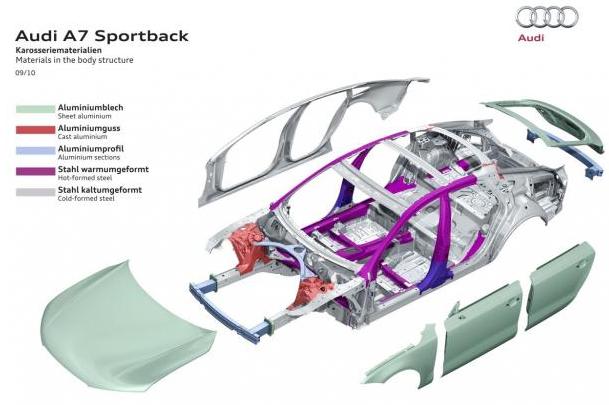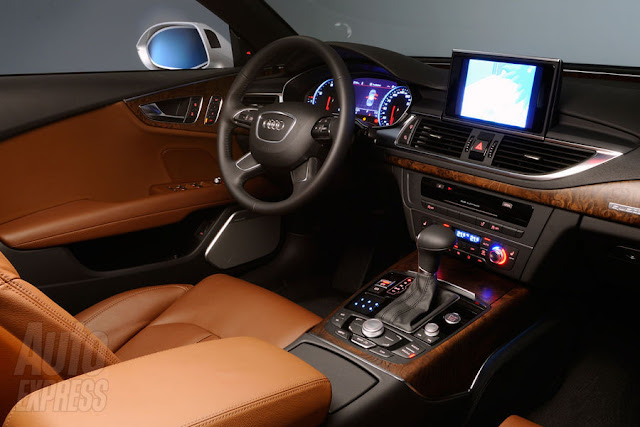The Audi R8 GT: Extreme lightweight construction and tremendous performance
The R8 high-performance sports car has been a winner from the very beginning. This applies to both the production models, winners of the “World Performance Car” Award in 2008 (R8) and in 2010 (R8 V10), and to the race car, the R8 LMS, which won 23 races in its first season and claimed three championships. The genes of the race version are now coming to the street – in the R8 GT. The exclusive series is limited to 333 units. Each R8 GT has a badge with its production number on the shift lever knob.
Consistent use of lightweight construction: 100 kilograms (220.46 lb) trimmed
The production R8 5.2 FSI quattro is already a shining example of the Audi’s lightweight construction philosophy. Its aluminum Audi Space Frame (ASF) body weighs only 210 kilograms (462.97 lb). The aluminum body panels are joined to the frame of extruded profiles and cast nodes by means of positive and friction connections. The engine frame is made of ultra lightweight magnesium.
The ASF body is largely hand-built at the Neckarsulm plant in a complex manufacturing process. The extremely high strength of the body is the basis for the high-performance sports car’s precise handling, and it also offers good vibration comfort and first-rate crash safety.
Thanks to the ASF body, the production R8 5.2 FSI quattro weighs only 1,625 kilograms (3,582.51 lb) – with quattro permanent all-wheel drive and optional R tronic transmission. This made it all the more difficult for the engineers to once again achieve substantial weight savings. They took an elaborate approach involving every aspect of the vehicle, and in the end the scales came to rest at 1,525 kilograms (3,362.05 lb).
The windshield of the R8 GT is made of thinner glass; the bulkhead between the passenger cell and engine compartment, as well as the window in the rear hatch are made of strong, lightweight polycarbonate. These three modifications saved nine kilograms (19.84 lb). The fixed rear wing is good for an additional 1.2 kilograms (2.65 lb); thinner sheet metal and additional cutouts shaved 2.6 kilograms (5.73 lb) from the aluminum hatch over the 100 liter (3.53 cu ft) luggage compartment at the front of the car.
The long rear hatch is made of carbon fiber-reinforced plastic (CFRP) – an advantage of 6.6 kilograms (14.55 lb). The rear bumper and the sideblades of this same material save an additional 5.2 and 1.5 kilograms (11.46 and 3.31 lb), respectively. With its minimal weight and extremely high strength, CFRP is the ideal material for a high-performance sports car, and Audi has broad-based expertise in its use.
The engineers also fought to shave every possible gram of weight from the technical components of R8. They shaved one kilogram (2.20 lb) from the power brake system, four kilograms (8.82 lb) from the aluminum caps of the brake discs and 9.4 kilograms (20.72 lb) from the battery. The engineers also found 2.3 kilograms (5.07 lb) in the air intake module and 2.8 kilograms (6.17 lb) in the insulation of the engine compartment.
The interior also harbored substantial weight-savings potential. The new, lightweight carpeting accounts for 7.9 kilograms (17.42 lb); the bucket seats with a chassis of glass-reinforced plastic (GRP) account for 31.5 kilograms (69.45 lb). Numerous additional detailed measures targeted the interior, the exterior and the technology, such as higher-grade, lighter steel for the exhaust system’s tailpipes.
Even sharper and more effective: the design
The design of the Audi R8 GT is the expression of concentrated power – a beautiful, technical sculpture measuring 4.43 meters (14.53 ft) long, 1.93 meters (6.33 ft) wide and only 1.24 meters (4.04 ft) high. The exterior underwent numerous modifications that further sharpened the appearance. Many of them also reduce the weight and enhance the aerodynamics. The R8 GT produces even more downforce when driven fast than the production model – without any increase in the Cd value (0.36) or frontal area (1.99 m2) (21.42 sq ft).
The frame of the single-frame grille, its struts and the slats in the air intakes are finished in matt titanium gray; the grille is painted matt black. The splitter under the bumper has a double lip and is made of carbon. Slender, curved flics at the corners of the nose increase the downforce on the front axle and are also made of a carbon fiber composite.
One highlight of the R8 GT are the standard LED headlights, which use light-emitting diodes for all functions. They produce bright, homogeneous light, have a long service life and low energy consumption. The headlights also have an attractive and distinctive appearance. The daytime running lights each comprise 24 LEDs and appear as a continuous band. The reflectors are reminiscent of open mussel shells.
The defining element of the side view are the sideblades, which direct air to the engine and in the R8 GT are also made of matte carbon. The same material is used for the reduced-size housing of the side mirrors, which are mounted on an aluminum base. The 19-inch wheels feature an exclusive five twin-spoke Y design in a titanium-look finish. The front fenders sport “GT” badges.
The modifications to the rear of the car are particularly apparent, beginning with the fixed wing of matte carbon. The ventilation louvers on both sides of the rear hatch and the CFRP bumper, which integrates the large, round tailpipes and vents for the wheel wells, have been redesigned. The larger diffuser is made of carbon fiber composite; the license plate bezel and the wide slats at the rear are in matte titanium gray. The tail lights, which also use LED technology, have dark housings with panes of clear glass.
Audi offers the R8 GT in a choice of four body colors: Samoa Orange metallic, Suzuka Gray metallic, Ice Silver metallic and Phantom Black pearl effect.
Breathtakingly powerful: the 412 kW (560 hp) 5.2 FSI
The modified V10, whose cylinder head covers are painted red, gives the Audi R8 GT breathtaking performance. The R8 GT sprints from a standing start to highway speed in 3.6 seconds, and from zero to 200 km/h (124.27 mph) in 10.8 seconds. And the thrust does not let up until the top speed of 320 km/h (198.84 mph) is reached.
Changes to the engine electronics coaxed an additional 26 kW from the ten-cylinder, which now produces 412 kW (560 hp) from a displacement of 5,204 cc. The torque curve peaks at 540 Nm (398.28 lb-ft) at 6,500 rpm, 10 Nm (7.38 lb-ft) more than in the production version. The V10 has a specific power output of 79.2 kW (107.6 hp) per liter displacement. Its power-to-weight ratio is 3.70 kilograms (8.16 lb) per kW or 2.72 kilograms (6.00 lb) per hp. The engine redlines at 8,700 rpm.
The long-stroke engine (bore x stroke 84.5 x 92.8 millimeters [3.33 x 3.65 in]), which is hand-built at the factory in Györ, Hungary, features a crankcase made of a aluminum-silicon alloy that is both lightweight and very strong. A bedplate – a frame for the crankshaft bearing bridges – further enhances its rigidity. The complete engine weighs only 258 kilograms (568.79 lb). It is characterized by a cylinder angle of 90 degrees and dry-sump lubrication, which uses a highly efficient oil pump module. Both solutions lower the center of gravity and thus improve driving dynamics.
The crankshaft is designed as a common pin shaft. The connecting rods of the opposing pistons engage a common crankpin, resulting in alternating firing intervals of 54 and 90 degrees. This unique rhythm gives the V10 its fascinating sound – a grand, technical music very much like that in racing. Two flaps in the exhaust system modulate its volume and tone as a function of load and engine speed.
The normally aspirated engine consumes an average of 13.7 liters of fuel per 100 km (17.17 US mpg) – very good fuel economy given the tremendous power. The FSI gasoline direct injection system injects the fuel into the combustion chambers at up to 120 bar of pressure. The turbulent mixture cools the cylinder walls, enabling a compression ratio of 12.5:1. A variable intake manifold and the continuous adjustment of the chain-driven camshafts ensure that the combustion chambers are fully filled. Flaps in the intake ports facilitate the formation of the mixture by inducing a tumbling motion in the inflowing air.
 Burj Khalifa
Burj Khalifa 
























